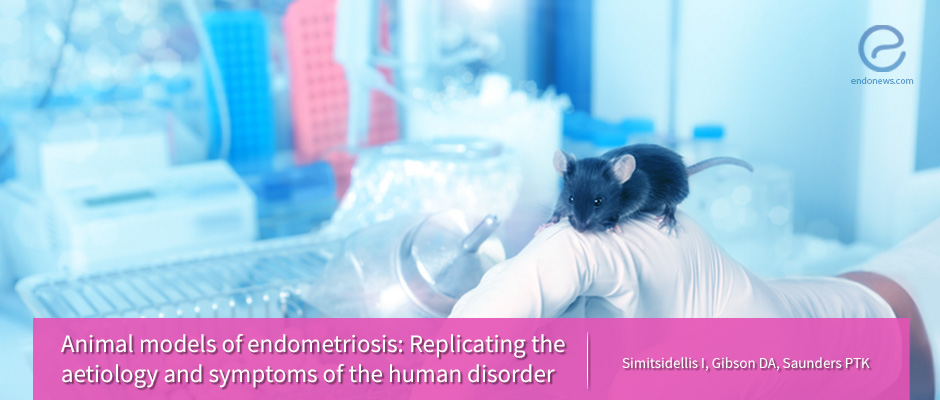Animal models of endometriosis
Jun 4, 2018
Understand etiology and symptoms of human endometriosis through animal models
Key Points
Highlight:
- The complexity of endometriosis means that it is difficult to recapitulate the human disorder using animal models.
Importance:
- New non-surgical therapies for endometriosis remains urgently needed, however, without appropriate preclinical testing animal models, it is difficult to develop and validate the efficacy of new drugs.
What's done here:
- This is a review article to describe animal models, including primate, rodent and xenograft and how useful they are to our understanding of endometriosis and associated symptoms such as pain and infertility.
Data:
- Primates (cynomolgus monkeys and baboons) can be used as endometriosis model as they can develop the condition naturally or through induction. However, primate study model is expensive from housing and research perspectives.
- Rats model requires ways to induce ‘endometriosis’ and reported methods using surgery do not fully phenocopy human lesions, however, they were valuable to demonstrate innervation of lesions and improved our understanding of pain pathways activation.
- The mice model is advantageous to selectively study certain genes in estrogen signaling and inflammatory processes through transgenic approach. The endometrial tissue could be labeled by fluorescent proteins to monitor progression. Methodologies to induce endometriosis include
- (i) allogeneic mouse uterine tissue dissected and stitched back onto the intestinal mesenteric vessels, peritoneal wall or injected into the peritoneal cavity; and
- (ii) a syngeneic approach where the uterine tissue from donor mouse is introduced into a different mouse.
- The advantage is the use of relevant human tissue type, but immunocompromised mice limit modeling of inflammatory processes that occur in real endometriosis.
- New approaches are needed to model the impact of peripheral, ovarian and deep endometriosis on pain and infertility.
Lay Summary
For advancing understanding and treatment of endometriosis, The World Endometriosis Society has previously brought together researchers and clinicians to discuss the many important research priorities. One of these was the recommendation to development and building on the use of animal models for future endometriosis research activities.
Endometriosis is a complex disease to mimic. It can broadly be classified into peritoneal, ovarian and deep infiltrating depending upon the location, extent, and appearance of the lesions. Furthermore, American Society for Reproductive Medicine has classified endometriosis based on the phenotypes into stage 1 (minimal), stage 2 (mild), stage 3 (moderate) or stage 4 (severe). Moreover, the women with endometriosis suffer from debilitating symptoms of chronic pain and infertility that may be constant or fluctuate.
This article by Simitsidellis et al. published in Best Practice & Research Clinical Endocrinology & Metabolism from Medical Research Council Centre for Inflammation Research, The University of Edinburgh, Queen's Medical Research Institute, Edinburgh, UK discusses animal models (primate, rodent, and xenograft) and their use to advance our understanding of endometriosis and associated symptoms such as pain and infertility. The article used search methodology on Medline (Pubmed) for research conducted using ‘animal model’ and ‘endometriosis’ up to August 2017. This review focused on models that were previously shown to recapitulate key features of the human endometriosis to highlight advances in explaining the disease etiology and also platform for preclinical testing.
Primates: These include cynomolgus monkeys and baboons. Spontaneous disease in cynomolgus monkeys resemble those in human but will require large breeding facility due to low incidence. They are expensive to use as research animal model, however, menstruating primates can develop spontaneous disease-causing disease severity with the obvious change in behaviors. The protocols to induce endometriosis lesions in the peritoneum of baboons using autologous inoculation of menstrual tissue is possible.
Rats: The rat model will require ways to induce ‘endometriosis’ lesions. Previously reported methods include auto-transplanting small fragments of uterine horns (myometrium and endometrium) onto the peritoneum. Such procedure can result in cystic lesions and impaired fertility. Other models include suturing small pieces of the uterus (or fat) onto mesenteric arteries, abdomen, and ovary. This latter method was valuable to demonstrate innervation of lesions and informed our understanding of pain pathways activation.
Mice: The mice model is advantageous to selectively study certain genes, for example in estrogen signaling and inflammatory processes through transgenic approach. Endometrial tissue can also be made to express fluorescent proteins to monitor progression. Methodologies to induce endometriosis in mice include (i) allogeneic mouse uterine tissue dissected and stitched back onto the intestinal mesenteric vessels, peritoneal wall or injected into the peritoneal cavity; and (ii) syngeneic approach where the uterine tissue from donor mouse is introduced into a different mouse.
Human cell and tissue xenograft models: To successfully establish these lesions, immunosuppressed recipients are required including the nude, NOD/SCID, Rag2/gammaC mice models as hosts for the human tissue. The advantage of this model is the use of relevant human tissue type, but immunocompromised mice limit modeling of inflammatory processes that occur in endometriosis.
To this point studies in animal models have extended our understanding such as the contribution of estrogen to the disease development and pathogenesis. In addition, data shown in neoangiogenesis lesions in rats and mice are in agreement with those observed in women. Infertility has also been shown in rodents with induced endometriosis that associated with the adverse ovarian phenotype.
In conclusion, there are clear advantages to using primates as they have menstrual cycles, although their use is very tightly regulated and expensive in terms of future drug testing. On the other hand, rodent models offer a more feasible platform to test drug’s efficacy in treating pain or infertility. Thus, more work is needed to improve modeling of ovarian and deep infiltrating endometriosis in animal systems.
Research Source: https://www.ncbi.nlm.nih.gov/pubmed/29779580
animal model preclinical

